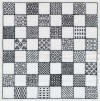Blackwork Embroidery is normally simply referred to as "Blackwork".
It is a simple form of embroidery, using black thread on white or off-white fabric.
Technique
Blackwork is usually executed on evenweave fabric that is easily countable. Any black thread can be used, but firmly twisted threads of any material give a better look than embroidery floss. Sometimes metallic threads or colored threads are used for accents. The stiches used are double running stich, which is also called holbein stich or backstich and sometimes stem stich.
Historically, there are three known techniques to execute blackwork.
- The stiches are executed following a counting pattern, creating both the bigger shapes and small filling patterns. Most modern blackwork follows this pattern, especially the commercially produced patterns that are marketed for hobby stitchers. The whole embroidery looks somewhat geometric.
- The shapes, which can be curvilinear, are surrounded by outlines made fom stem stich and then filled with geometric patterns
- The entire embroidery is curvilinear, and often uses random stitches, so-called seed stitches, as filling rather than geometric patterns. This style was invented to mimic etchings.
History
Historically, blackwork was used on clothing in the time of Henry VIII. Initially it was known as "Spanish work" since Catherine of Aragon is said to have brought many blackwork dresses with her from Spain. A favourite motif on her clothing was the pomegranate which was used as a heraldic device in Granada, where Catherine lived as a child.
Blackwork continued to thrive under the reign of Elizabeth I, but it lost its popularity during the 17th century.
Modern blackwork
Today, blackwork is more popular than ever. It has a modern feel, due to its austere, formal quality. Much of the success of a blackwork design depends on how tone values are translated into stitches.
Amongst the motifs used, maps are parlicularly popular, also chessboards, in fact anything which could be the subject of a pen and ink drawing.
Blackwork is also an integral part of Assisi Embroidery where it is used to outline the main motif and some of the decoration. Both modern and folk-art cross-stich are sometimes combined with blackwork or similar backstich embroidery.

